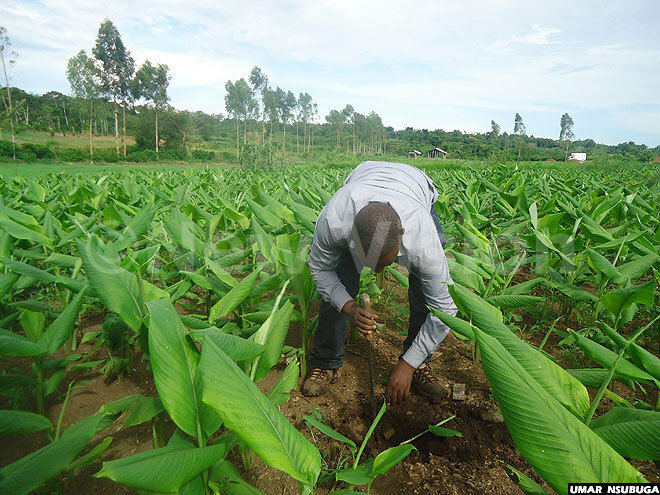Turmeric, the 'golden spice of life'
"Among all crops, turmeric is the least affected by pests and infestations."
PIC: Dr. Kakooza shows a sample of a turmeric root. (Credit: Umar Nsubuga)
Dr. Twaha Kakooza from Bubejjwe village in Kayunga district does not claim to be an experienced farmer, but a casual chat with him reveals just how knowlegeable he is in farming.
He is particularly interested in turmeric, a perennial plant of the ginger family used by many as a spice.
"Among all crops, turmeric is the least affected by pests and infestations," says Kakooza.
While the root crop receives less attention from Ugandan farmers, Kakooza says it has huge potential for both local and international markets.
'Golden spice of life'
"It is a tropical perennial plant native to India and Indonesia and is cultivated throughout the tropics around the world".
Known as the "golden spice of life", turmeric is one of the most essential spices in the culinary world. It is also embraced for its medicinal properties as well.

But why is its production still low in Uganda?
Kakooza says lack of awareness on the potential and uses of turmeric is among reasons why most Ugandans do not go into its production.
"In fact turmeric production is left in the hands of few farmers because first of all it takes nine months to grow, yet some farmers see it as a long time for it."
He also says low turmeric production in Uganda is due to lack of credit facilities for smallholder farmers, a situation that makes it difficult for them to procure fertilisers and other agro-chemical inputs for sustainable turmeric enterprise.
Turmeric, which looks like ginger in its original form, has a vast variety of medicinal uses.
"In traditional medicine, it is used to treat liver ailments, ulcers, parasitic infections, skin problems, bruises, joint pain and inflammation, sprains, strains, among others.
Cultivating it
Turmeric is grown both under rain-fed and irrigated conditions. Like other tuber crops, it requires deep soil tilt and heavy manure for high yields.

According to Kakooza, after selecting a suitable cultivation site, beds of convenient length and width are prepared, based on the topography of your land.
He says the soils for this plant should be rich and friable with plenty of organic matter. "Though turmeric is suited for a number of soil types, loam and sandy-loam soils are preferable. Flat land with little or no slope is recommended, it can be manually done using a spade or a hoe.
The suitable planting distance of 50cmx30cm is often adopted for turmeric planting.
According to Kakooza, turmeric can also be grown in an intercropping system with other crops such as maize, pepper and mung bean.
Aisha Nabossa, the manager at Shatwa Mixed Farm, says for good crop yield and maximum farmer economic return, it is advisable to mulch a turmeric plot after planting and fertilise it using a combination of inorganic fertiliser such as poultry or cow dung manures.
When the plant has changed from abundant green to dry, dig up the entire plant, ensuring that you dig up the entire root (as this is the part that is used medicinally). Plan to harvest your turmeric root at the end of the summer growing season.
Turmeric's readiness for harvest is indicated by the drying of the plant and stem, approximately seven to 10 months after planting, depending on the soil and growing conditions.
Globally, the world production level for turmeric is between 11-16 tonnes annually and out of these production figures, India accounts for over 78% of the annual production for turmeric.
India is followed by China and Myanmar in Asia. Nigeria is the fourth largest producer of turmeric with about 3% of the global annual production.